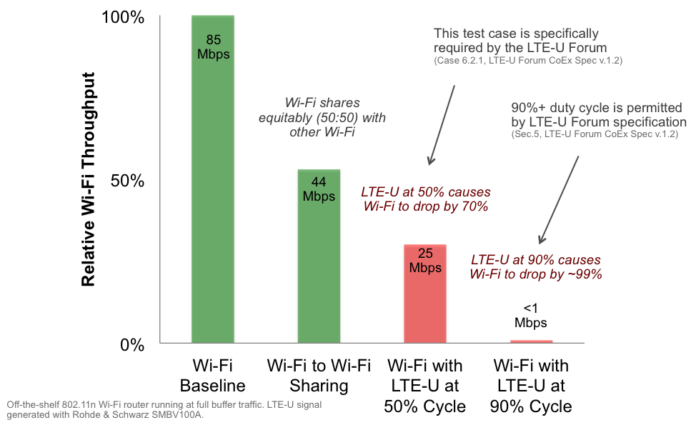LTE operating in unlicensed spectrum interferes with Wi-Fi performance
WASHINGTON – In a recent blog post, nonprofit research consortium CableLabs said it has found a variety of issues that may impact Wi-Fi and LTE-U coexistence.
From the post: “If our Wi-Fi AP [access point] performed better in the presence of LTE-U, that would validate the claims made about it being a better neighbor. But, we unfortunately did not find that. Quite the opposite, in fact. Our results showed that Wi-Fi performance suffered disproportionately in the presence of LTE-U. Wi-Fi throughput (speed) is degraded by 70% when LTE-U is on only 50% of the time, for instance. And more aggressive LTE-U configurations (longer ‘on’ times) would do even more damage.”
This post is the latest in a series of articles CableLabs has run alleging LTE-U degrades Wi-Fi quality. However, proponents of LTE-U, including CTIA, the largest wireless industry trade association, argue CableLabs may be motivated by something other than pure research.
Tom Sawanobori, SVP and CTO of CTIA, said, “The cable industry’s cable-only lab results are flawed and misleading, which is not surprising given the motivation of the cable industry to block new innovation and investment in unlicensed bands. Contrary to [the] cable industry’s view, unlicensed spectrum is not their industry’s exclusive spectrum.”
CableLabs made sure to point out the findings don’t categorically condemn LTE-U, noting the results highlight the need for open and collaborative research and development.
Neville Meijers, SVP of business development for Qualcomm, discussed the issue with RCR Wireless News during the recent CTIA Super Mobility Show. Meijers pointed to numerous tests conducted by Qualcomm and others that suggest Wi-Fi and LTE-U can share spectrum; so what’s the holdup?
“I think it has gone beyond a technical discussion,” Meijers said. “I think it’s a business issue. Now it’s really a discussion around the opportunity for wireless carriers to utilize unlicensed spectrum. They’re already utilizing the unlicensed spectrum for purposes of data offload and giving consumers a better experience. If that experience can be enhanced through LTE-U … why not leverage that?”
Regulators at the Federal Communications Commission have reached out to the broader telecom industry seeking information on LTE-U.
Efforts to promote coexistence are ongoing. The Wi-Fi Alliance, for instance, is holding a working group in Palo Alto, Calif., to address the question of coexistence. Wi-Fi Alliance leaders and many in the industry are hoping to keep the FCC from becoming involved in the issue.
“An environment with minimal regulation has served us well for over 30 years,” Wi-Fi Alliance President and CEO Edgar Figueroa said. “We believe the industry can address coexistence.”

